[Moderator note: Moved from Plants and Gardens/General Alpines/Don't Forget the Red Ones!]
This (Antennaria dioica) is a common plant in the subalpine zone and in the lowland woods and higher up in the mountains too. You get it in different colors between red and white. The red ones are showiest.
I've not felt comfortable trying to name the small silver Antennarias, which are common here, and at all of the various sites I have visited in Alberta-- dry southern badlands, Aspen parklands east of here, foothills, montane zones, higher up, etc; I have read they are especially prone to the self fertilisation causing numerous clones as opposed to cohesive species, which we were discussing re: Taraxacum etc
I have real doubts about labelling species in this genus based on pink flowers, at least in my area-- patches of otherwise identical pink and white flowered plants grow side by side-- knowing that they may not be interbreeding suggests they could be separate 'species', but by that measure so could individual plants of the same colour :rolleyes:
In any event, they are common as I said, and have done very well for themselves in heavily grazed pastures here, and will grow well in sun or shadier places (not so common in woodlands, but used to being shaded by grasses etc)--there is a patch remaining from bits I planted as a teen in a long gone bit of rock garden which is now on the north side of grown up spruce trees..
If anyone is still interested in pink flowering Antennaria next summer, I can mark a plant to collect seed, or very easily take a few cuttings which grow very easily....
I think the genus deserves its own thread, if it doesn't have one already ;D I'm very interested in those with black phyllaries (is this the word I want? just went blank) and with single heads...

Comments
Trond Hoy
Re: Antennaria
Sat, 02/26/2011 - 2:25amWe have 5-6 different species of Antennaria here but A dioica is the commonest. I think it is separate sexes of the plants and females being the red ones (if I remember right) and males the white ones. But then, what about the pink ones?
cohan (not verified)
Re: Antennaria
Sat, 02/26/2011 - 10:21amWe have no red, only pink and white, sometimes the pink ones look sort of bicolour, though I'm not convinced that's not at least partly about when you look at the flower--the flower heads change a lot from beginning to end, and I can't say I have looked carefully enough in careful sequence to follow the whole cycle-- I think as with Salix, Betula, Alnus, as I mentioned elsewhere, I need to tag individual plants and follow them through the season..
I have yet to look at Antennarias in Flora of Alberta and see if that helps me any. We have a couple other species clearly distinct from these little silver ones-- a really nice larger rosette sp with dark green tops, white underneath, more of an open woodland plant, and A pulcherrima--with large upright leaves, growing in damp places..
Lori S. (not verified)
Re: Antennaria
Sat, 02/26/2011 - 3:45pmAs Cohan says, we have no red Antennaria here, only whitish to white to shades of pink. Are there any truly red Antennaria anywhere, as opposed to dark pink? It is clearly something I need to get, if so! ;D
Mark McDonough
Re: Antennaria
Sat, 02/26/2011 - 5:57pmI just happened to be gathering up photo links for Antennaria. Both A. rosea and A. dioica have some very deep color forms that "approach" red, probably actually a very deep pink. Here's some photo links of each species, ones selected for the deeper colors:
Antennaria rosea
http://lh3.ggpht.com/_zWbDkdxJAyE/SIVAAiAPndI/AAAAAAAAEak/ldI0CK_r-CU/s7...
http://lh3.ggpht.com/_Hz8TUPlYNG8/SGinxjnEGII/AAAAAAAAAQA/QkCH8JOLv_8/s7...
http://lh4.ggpht.com/_xyII2Q5ikJA/SDQvGzH8HsI/AAAAAAAAHVc/7z63Mb8zboM/CR...
http://www.flickr.com/photos/bigskykatie/2623200024/
http://www.flickr.com/photos/patrickstandish/5389151751/
http://www.flickr.com/photos/patrickstandish/5389755350/
http://www.flickr.com/photos/13095250@N03/1452025594/
Antennaria dioica
http://picasaweb.google.com/lh/view?q=antennaria&psc=G&filter=1#53671916...
http://www.flickr.com/photos/willowherb/3613937415/
http://www.flickr.com/photos/14807213@N05/2502143399/
http://www.flickr.com/photos/12639178@N07/3761224716/
Cohan had suggested having an Antennaria topic, and I'll work on creating one (the reason I was gathering some photo links). :D
Richard T. Rodich
Re: Antennaria
Sat, 02/26/2011 - 7:12pmYes, that's the way Antennaria rosea var. confinus grows for me too:
cohan (not verified)
Re: Antennaria
Sat, 02/26/2011 - 7:27pmsome nice ones there, Mark--
I like the two for Patrick Standish, and the A dioica rubra!
(interestingly, probably because I am signed in to Gmail/google, all the picasa links come up the same for me, a page with half the images mine from picasa...lol)
Here are a few more shots from around here, since we are heading for a thread ;D
I'll save the whites till the new thread arrives
Here's a pale one from a site a few miles away, edges of a wet ditch, not far from Primula, Pedicularis, Spiranthes, Gentianopsis etc
album: https://picasaweb.google.com/cactuscactus/June282010APrimrosesSparrowSEg...
another wet place a few miles away
cohan (not verified)
Re: Antennaria
Sat, 02/26/2011 - 7:39pmAnd these are from a colony here on the farm-- a pasture with numerous patches of both white and 'pink' plants...
I hadn't realised till now looking at some of these shots (I hadn't edited these photos till today, still don't have the album ready).
Of course, looking at these pretty flowers, its good to remember the overall effect, last photo..though I don't mind a little mess ;)
Mark McDonough
Re: Antennaria
Sat, 02/26/2011 - 8:14pmYou're right Cohan, it appears that Picasa links do not translate globally. What I did to correct the problem, is load the Picasa photo, then right-click and select "Copy Image Location", then paste that location into a fresh tab in my browser, to find the true static location of that image... so I have updated my original post with links that work. I like the pink-flowered form you posted pictures of, very pretty.
Rick, your plants of Antennaria rosea var. confinus are deep-color indeed, very showy. Are these plant from collections made in your area?
Tomorrow I shall move the pertinent Antennaria messages to a new topic. Cheers.
Mark
cohan (not verified)
Re: Antennaria
Sat, 02/26/2011 - 8:59pmMark,those are some nice deep coloured ones! Rick's form is nice too..
Richard T. Rodich
Re: Antennaria
Sun, 02/27/2011 - 7:59amNo. We don't have Antennaria rosea wild here. That is a plant I have lost track of, but it was a plant that I bought from a place like Arrowhead Alpines.
Trond Hoy
Re: Antennaria
Sun, 02/27/2011 - 9:43amCohan, the pussyfoots you show could as well have been A dioica! They look very similar to those I find here.
Trond Hoy
Re: Antennaria
Sun, 02/27/2011 - 9:46amWhat would you call the color of the A dioica in the very first entry in this thread, Lori?
cohan (not verified)
Re: Antennaria
Sun, 02/27/2011 - 10:06amTrond-- I just glanced quickly at Flora of Alberta, which says 'A difficult group and the status of species is problematical' interestingly, they don't use the name A dioica; there are several other species which could be in my area based on the maps, and it will no doubt take some scrutiny of keys and descriptions (and some study to understand those ;) and examining plants in the field with the right characters in mind!-measuring involucres and counting stem leaves etc...
Lori S. (not verified)
Re: Antennaria
Sun, 02/27/2011 - 10:12amUnequivocally pink to me, Trond. :) However, having said that, it raises a very good point! One's determination of colour is rather subjective, even beyond the differences that can be imposed by different monitors. I have often thought of buying the RHS colour charts in order to see and be able to compare to the "standards"... maybe I will finally get them.
The cost is £170 for the full size version (ouch!); the mini version is £25:
http://www.rhs.org.uk/Plants/RHS-Publications/RHS-colour-charts
Stuart has also expressed an interest in these... which would help to justify the rather exorbitant cost ;)... in order to compare to descriptions of water lilies (which note the RHS standards), since quite a few seem to come mislabelled.
Trond Hoy
Re: Antennaria
Sun, 02/27/2011 - 10:51amAs you say, one's determination of color is subjective and, I will add, depending on language as well! What you call unequivocally pink, I call red, at least when compared to the white forms of that plant - however compared to the Silene virginica it's another case!
Pink is the color of "the pink panther" to me ;) (In Norwegian we usually call that color "rosa")
A color chart could have been very useful, but I know even better things to buy for that amount of money ;D
Lori S. (not verified)
Re: Antennaria
Sun, 02/27/2011 - 11:12amThis is interesting... the Azalea Society of America's reproduction of a colour chart, showing correspondence to the RHS chart:
http://www.azaleas.org/index.pl/rhsmacfan1.html
Trond Hoy
Re: Antennaria
Sun, 02/27/2011 - 11:47amOK, Lori, I'll bring my Mac with me next time I have to find a color name ;D
Lori S. (not verified)
Re: Antennaria
Sun, 02/27/2011 - 12:16pmI'll just get myself one of these to carry with me... weighs much less than my MacBook. ;D
http://www.tintoyarcade.com/products/Pink-Panther-Flexible-Figure-1964.html
Trond Hoy
Re: Antennaria
Sun, 02/27/2011 - 12:28pmYes!! This one is pink. And all other colors are red :o (if they're not yellow, blue or green) ;D ;D
cohan (not verified)
Re: Antennaria
Sun, 02/27/2011 - 3:06pmI'd call most of the Antennarias we've seen pink, some are quite deep, I might say purply pink or even burgundy..
For me, coming from a painting direction, true red should have neither yellow/orange tones (scarlet) nor blue/violet tones, and if lightened should yield a clear pink, not a salmon or coral, nor a purply magenta colour...
Thank goodness that these days one can include a photograph easily with a plant description, and not rely on words alone! Of course we still have to rely on accuracy of cameras and monitors....
Lori S. (not verified)
Re: Antennaria
Mon, 05/30/2011 - 8:45pmI thought there may have been a thread started for this genus, but I couldn't find it, if so, so here goes...
Antennaria are starting to bloom here... the group includes many great groundcover plants, with neat foliage, and some (reasonably ;)) showy flowers among them, too.
Antennaria umbrinella (or so my map claims, at any rate. ;D)
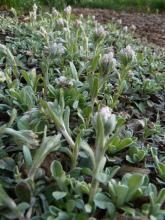
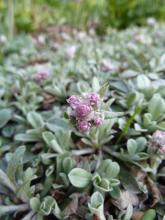
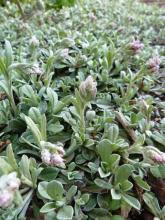
Todd Boland
Re: Antennaria
Mon, 01/16/2012 - 7:08amWe used to have 12 species of Antennaria in Newfoundland...now they are combined into just 5, bucking the trend of splitting rather than lumping. All of ours have rather drab flowers....A. alpina is our nicest for tight form and most silver foliage. I rather like some of the western pink ones.
Trond Hoy
Re: Antennaria
Mon, 01/16/2012 - 11:06amI haven't noticed this thread till now - thanks to Todd ;)
This is the best colours I have found here - all the same species Antennaria dioica!
Todd Boland
Re: Antennaria
Tue, 01/17/2012 - 4:17pmStrangely we have native A. rosea which is pink out west but off-white in Newfoundland!
cohan (not verified)
Re: Antennaria
Wed, 02/01/2012 - 3:36pmWe get some coloured ones here, but nothing as bright as Trond's.. Lori, there was a good stretch of earlier posts on the genus, in a thread about red flowers, I think....
Lori S. (not verified)
Re: Antennaria
Wed, 02/01/2012 - 10:15pmCohan, I've moved most of the discussion about Antennaria that was in Plants and Gardens/General Alpines/Don't Forget the Red Ones! over to this thread. There are still some posts about Antennaria there (it would have seemed disruptive to the rest of the thread to move them all) but all references to Antennaria can be found at any time by going to the main forum screen and doing a search. :)
Lori S. (not verified)
Re: Antennaria
Wed, 02/01/2012 - 10:23pmI haven't got down to ID'ing many Antennaria species yet, but here are a couple of nice alpine ones. Any guesses? The flowers are not colourful but the foliage is noteworthy, particularly on the second one which is quite gorgeous:
Here's a tiny grassland species (with my gloved finger for scale):
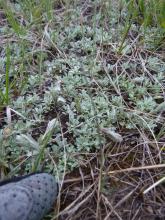
Cliff Booker
Re: Antennaria
Wed, 02/01/2012 - 11:50pmWow Lori, the second one would grace any garden or the foliage class at any alpine show. Stunning.
cohan (not verified)
Re: Antennaria
Thu, 02/02/2012 - 12:05amHaving done some reading at the Eflora of North America on the genus, its seems pretty tricky for many species, and a lot of the common silver leafed ones (at lower elevations at least, seems maybe some of the alpine ones are more distinct?) seem to get tossed around among several species... I think id will involve measuring the flower heads, checking for colour of bracts on outside of flowers, and in some cases looking for a 'tag' if I'm recalling the word they used, on leaf tips...
I think I finally decided on one of the upright species, but still not 100% sure!
I thought some readers might enjoy following my process of identification---
This colony is just a few miles from me, It seems to be an occasional species around here, not super common like the mat forming types (I have a plant growing from a cutting taken at another site several miles the other direction from me, will have to look at it in flower and see if it's the same). I had id'd this plant as Antennaria pulcherrima, based in part on the habitat type (moist areas, both sites I've seen it here, and some plants seen in the montane zone were also in a wet/seasonally wet place; I'm not sure these habitat constraints always apply in my immediate area, since we don't have any really dry grassy areas, and I think grazing, clearing etc may skew habitat opportunities ), as described in Eflora of North America, vs the similar A anaphaloides, said to favour dry sites....
However, as I started studying the details and maps in the Flora of Alberta, I was unsure- anapholoides seemed more likely to be in my area by the maps, and both talked about dark dots at the base of bracts (anaphaloides), and or dark bracts in general (pulcherrima).. the bracts on the flowers I photographed are more like tan, with dark dots only visible on some flower heads..
However, I finally decided anaphaloides should have whiter bracts , and likely shorter heads (involucres), and Eflora describes bracts for pulcherrima as ' black, brown, castaneous, or olivaceous' which should -sort of - cover the light but not white bracts on my plants; further, bract apices should be acute for pulcherrima and obtuse for anaphaloides-- so it comes down to the bracts- scales if you like, on the outside of the flower heads- these 'scales'/bracts should be mostly white with blunt or rounded tips for anaphaloides, and they should be darker and pointy for pulcherrima!
http://www.efloras.org/florataxon.aspx?flora_id=1&taxon_id=101977&key_no=3
Antennaria anaphaloides:
http://em.ca/garden/native/nat_Antennaria_anaphaloides.html
Antennaria pulcherrima:
http://em.ca/garden/native/nat_Antennaria%20pulcherrima.html
note: there are also male or female flower heads on these plants, and I think Antennaria flowers change in appearance quite a bit as they mature, so the flowers in my photos do not resemble either of these much, but just focus on the key features outlined above ;D
A couple of views, at the edge of a hayfield, right by the fence/roadside, moist/seasonally moist, depending on the year; July 27, 2010
Some closer views of the flower heads, starting with a fuzzy crop, in which you can see the dark spots at the base of the bracts, only occasional..
Lastly, some views of the patch in seed, October 07, 2010
Happy to hear any confirmation or any indication of where I might have gone wrong with this!
cohan (not verified)
Re: Antennaria
Thu, 02/02/2012 - 12:08amThis one was from Hilda Ridge- below the treeline, but not by much, on an exposed edge of the ridge with no trees nearby...
May 31, 2011, when growth would have just barely, if at all, begun for the season..
Trond Hoy
Re: Antennaria
Thu, 02/02/2012 - 8:27amSorry, I can't help you with names of your Antennarias. Seems you have many more species than wealthough both splitters and lumpers have done a lot with the few we have!
Antennaria alpina is the smallest but not the showiest except the lanate leaves (is lanate the correct term?). It flowers sparsely with white flowers.
Richard T. Rodich
Re: Antennaria
Thu, 02/02/2012 - 8:31amYou said it Cohan, about identifying low elevation Antennaria (at least)! Years ago I just through my hands up trying to ID with confidence which of the two possible species grew in the area where I grew up. I should revisit it again, especially with the FNA(Flora of North America) available online...
Lori, your first two pics might be the same species, but taken at different times or elevations? The "rhombic" crinkling of the leaves is sure attractive!
Lori S. (not verified)
Re: Antennaria
Thu, 02/02/2012 - 10:15pmI'm not sure... in these close-ups of the two plants, sometimes I think they are the same and sometimes I think they are different, and I am not familiar enough with Antennaria to be certain if they are the same species or not.
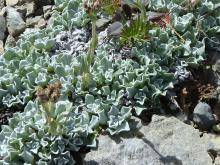
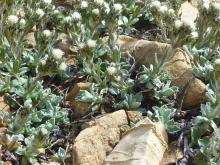
The photos were taken a week apart in mid-August last year, and the plants were growing at roughly similar elevations - the first at about ~2200m (drier conditions on a windy ridge that doesn't generally hold snow) and the second at about ~2600m elevation (much more snowfall here, generally moister conditions, with a few snowbanks persisting into mid-August):
Mark McDonough
Re: Antennaria
Fri, 02/03/2012 - 5:58pmLori, love the "rhombic" foliage shape on the alpine pussytoes, I agree with Cliff, worth growing for the foliage alone.
I took a photographic cruise around the genus Antennaria in two of my favorite web sites, but don't see any that look quite like the flat crinkly mats you show us Lori.
e-Flora of BC
On homepage, do a quick search on scientific name: Antennaria
Burke Museum of Natural History and Culture
Browse by genera, select Antennaria:
http://biology.burke.washington.edu/herbarium/imagecollection.php
Cohan, both of your links to the Saskatchewan's Wildflowers show excellent portraits of A. anaphaloides and A. pulcherrima. I must say, A. pulcherrima is an elegant species. I just lost an hour somehow, looking at just a few of the many photos on the "Sasakatchewan Native Plants / Wildflowers" site, quality photographs, showing plant scale and diagnostic plant features, I have bookmarked this site.
http://em.ca/garden/native/nat_photos.html
Looking through the site I ask myself, why haven't we heard of some of these exceptional plants; take a look at a few:
Erigeron radicatus:
http://em.ca/garden/native/nat_Erigeron%20radicatus.html
Chrysopsis villosa:
http://em.ca/garden/native/nat_Chrysopsis%20villosa.html
I have some Antennaria pics to post, but it is "tax weekend" for me, not sure I'll get a chance.
cohan (not verified)
Re: Antennaria
Fri, 02/03/2012 - 6:34pmI agree, Mark- the Saskatchewan site is excellent, and has been a great resource for me, since we have a number of wildflowers in common, and their section on garden perennials has been useful as well....
I do really like the 'tall' Antennarias as well, leaves can be quite pretty in fall as well (herbaceous unlike most of the mat formers)..
The Chrysopsis- also known as Heterotheca- villosa is another fave- I've photographed it in the foothills/montane zone- and sent some seed overseas ;D
Richard T. Rodich
Re: Antennaria
Fri, 02/03/2012 - 8:30pmI see what you mean, Lori. They do look more different closer up. :-\ ???
cohan (not verified)
Re: Antennaria
Fri, 02/03/2012 - 11:14pmThey seem different, but hard to say without knowing what the pertinent characters are for the species in question! From the bit of reading I've done in the key for Antennaria usually, details of involucre height, colours/shapes of bracts, besides foliar differences- and sometimes habitat /map will be a determinant...